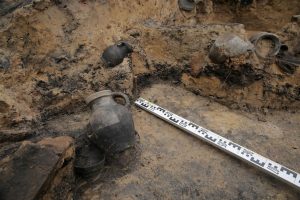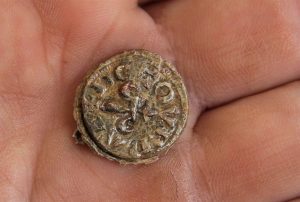Archaeologists excavating at the site of recently discovered Medieval settlement of Barczewko, also known as Alt Wartenburg, North Poland, discovered well preserved remains of basements, pottery vessels, and even a seal from textile imports all the way from Flanders.

The site is the first location of the present-day city of Barczewko, that was founded around 1330 AD by bishop Eberhard of Neisse. In 14th century it was called Alt Wartenburg. The town was completely destroyed in 1354 by a raid of Lithuanian army led by princes Kiejstut (also known as Kęstutis) and Olgierd (Algirdas). The site was completely abandoned and the settlement of Wartenburg was established a few kilometres to the East, where it thrives today as Barczewo. The scorched remains of the original settlement remained buried for centuries below the ground, until having been recently discovered through aerial photography and images captured by Jerzy Miałdun. The full extent of the city was revealed by geophysical survey by a team of archaeologists led by Piotr Wroniecki as part of a larger international project coordinated by Arkadiusz Koperkiewicz of Uniwersytet Gdański and Felix Biermann of Universität Göttingen. Archaeologists taking part in it excavated the site for three consecutive seasons.

The recent season of excavations unearthed remains of buildings located by the central square of the town. Archaeologists discovered well preserved basements, measuring 5 by 5 metres, with separate entrances. The buildings were fully wooden. The researchers also managed to unearth the cemetery of the original settlers, located in the north-eastern part of the site. Over a dozen burials were unearthed in various state of preservation. The deceased were buried in coffins with heads oriented towards West. By their remains few grave goods have been identified, in form of knives, buckles, bronze rings, and coins. It is possible that a church existed by the cemetery, but its location remains unclear at the moment. The skeletal remains are scheduled for anthropological analysis. In recent years the site revealed remains of numerous buildings, including one utility structure with a large bronze cauldron, tools, and vessels. Archaeologists have also unearthed remains of a complex of structures referred to as a “mercatorium” – serving economic and administrative functions. It was there that the researchers discovered metallurgical workshops, various tools, pottery vessels, jewellery, keys and padlocks, weapons, and a number of silver coins minted between 1317-1353.

(after Nauka w Polsce & Tomasz Waszczuk)